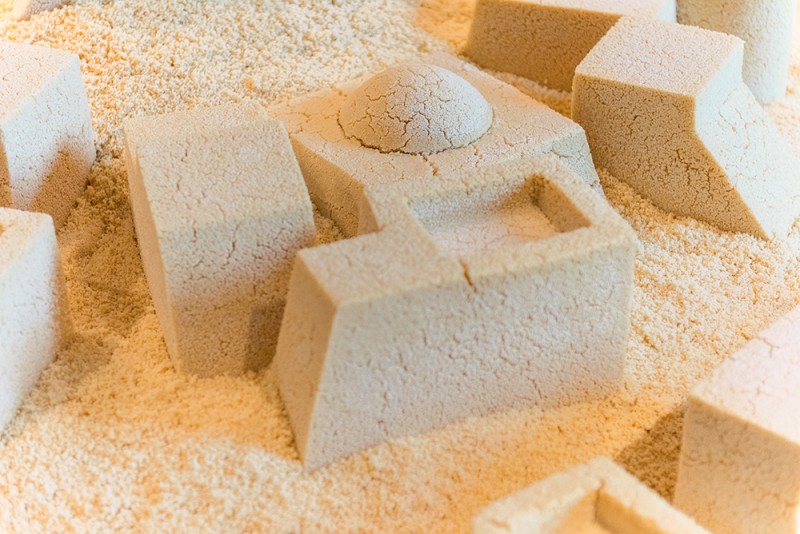“But a Storm is Blowing from Paradise: Contemporary Art of the Middle East and North Africa”
In Walter Benjamin’s analysis of Paul Klee’s Angelus Novus in his oft-quoted essay “Theses on the Philosophy of History” (1940) from Illuminations (New York, Schocken Books, 1969), the storm of progress blows an angel into the future with such force that he can no longer use his wings. Eyes wide, this “angel of history” surveys the accumulating wreckage of the present while being propelled into an unknown future. Although his critique of historicism and the continuum of progress was formulated in the throes of the Second World War shortly before he fled Vichy, France, the scene that Benjamin describes seems no less relevant today.
Installed on the ground floor of Galleria d’Arte Moderna (GAM) in Milan, “But a Storm is Blowing From Paradise: Contemporary Art of the Middle East and North Africa” is the final presentation of the UBS MAP Global Art Initiative. Curated by Sara Raza, the exhibition takes its name from a series of drawings by Iranian artist Rokni Haerizadeh, the title of which was inspired by the aforementioned passage from Benjamin’s “Theses.” Using printed stills of images from YouTube videos and news reports depicting moments of “public assembly” in the Middle East and North Africa, Haerizadeh transforms these scenes into surreal Boschian landscapes populated by hybrid human–animal forms. Recent years have seen a tremendous amount of money and intellectual capital being invested in “rewriting” and shifting canons, the UBS MAP program being only one such example. This is necessary and important work, especially as it offers an opportunity to think critically through the mechanism of the politics of how such “other” histories are written—and rewritten.

Kader Attia, Untitled (Ghardaïa), 2009, couscous, 16 feet 4.875 inches diameter, installation view, Galleria d’Arte Moderna, Milan, 2018. © Solomon R Guggenheim Foundation, 2018. Photo: Carlotta Coppo.
Artists participating in group exhibitions with a geographic remit are often expected to provide their audiences with a self-referential accounting of their history, politics and culture. “But a Storm” curator Raza attempts to complicate such an approach by building a collection exhibition rooted in the cross-circulation of concepts, bodies and histories. Raza calls upon notions of “conceptual contraband” and “smuggling,” as well as geometrical principles “to understand a set of constructed geographical spaces that are burdened by multiple representational principles and ideas.” Alongside the exhibition’s title work are works by 12 other artists exploring intersecting themes such as migration, displacement, architecture, geometry and history.
Lebanese artist Ali Cherri conflates geological and geopolitical unrest in his series of lithographs “Trembling Landscapes,” which depict aerial maps of Beirut, Damascus and Tehran (among others)—all cities on active fault lines that have seen their own share of social and political unrest. In his lightbox photo and video series “Disarm,” Saudi artist Ahmed Mater documents the urban transformation of Mecca, a city that has undergone tremendous gentrification—including historic landmarks being destroyed to make way for luxury hotels and malls. Mater shot the photographs from a military helicopter that was searching for unauthorized pilgrims to the holy city. In Afghanistan artist Lida Abdul’s In Transit, a group of young boys gathers around the shell of a bombed-out Soviet war plane on the outskirts of Kabul. The dream-like video pairs a reflective subtitle track that seems to share recollections from the past with images of the boys’ literally trying to reanimate it through the guise of repairing a fallen plane with cotton and rope.

Kader Attia, Untitled (Ghardaïa), 2009, couscous, 16 feet 4.875 inches diameter, installation view, Galleria d’Arte Moderna, Milan, 2018. © Solomon R Guggenheim Foundation, 2018. Photo: Carlotta Coppo.
Bulgarian artist Ergin Çavuşoğlu’s installation Dust Breeding translates the floor plan of a cement factory into an anamorphic drawing executed in vinyl on the floor of GAM. As visitors navigate the surface of the drawing, their movements are captured by a closed-circuit television camera. A nearby monitor shows the images, in which viewers appear to be standing in a three-dimensional structure. Canadian artist Abbas Akhavan’s Study for a Monument presents, on a humble white sheet, bronze casts of plants native to the Tigris and Euphrates river systems of Mesopotamia (an ancient region roughly corresponding with contemporary Iraq). Their charred, burnt appearance references the environmental devastation wrought on the region from decades of war, which decimated the Iraqi marsh wetlands and reduced them to dust. Dust is literally a relation between things: whether hair, sand, bits of dead skin or other organic matter. It comprises the living and the dead, the past and the present. In this way, it is a potent, if fickle, carrier of political narratives. Unruly geological contraband, dust is always on the move and does not recognize political, geographic or temporal boundaries. As Russian philosopher Michael Marder notes, “Dust clouds are dispersed, atmospheric events. One could say: diasporic. A spreading, creeping saturation.”
“But a Storm is Blowing From Paradise: Contemporary Art of the Middle East and North Africa” was exhibited at Galleria d’Arte Moderna di Milano, Milan, from April 11 to June 17, 2018.

